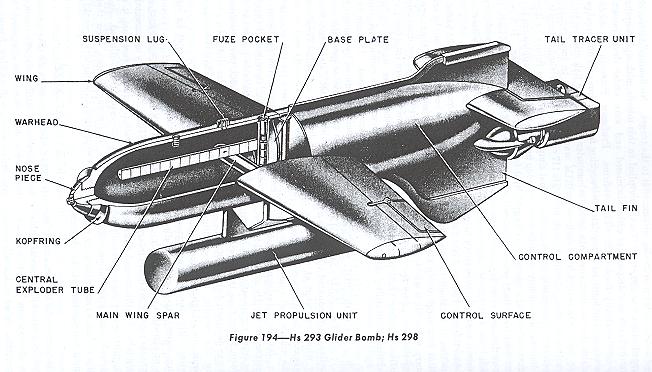|
109-507
The HWK 109-507 was a liquid-propellant rocket engine developed by Germany during World War II. It was used to propel the Hs 293 anti-ship guided missile. It was produced by Hellmuth Walter Kommanditgesellschaft (HWK). Like other Walter engines it used hydrogen peroxide as a propellant. Missile The Hs293 has been variously described as a missile or as a boosted glide bomb. It consisted of an SC500 bomb casing, fitted with wings, engine and radio control. Control equipment was housed in a rearward extension of the bomb casing but the motor was mounted in a separate housing beneath. It had originally been developed as an unpowered glide bomb, "Gustav Schwartz Propellerwerke", and the engine was added later. After flight tests, a visible tracking flare was also added, in a further rearward extension. As the engine was mounted below the missile fuselage, the exhaust nozzle pointed downwards at 30°, so as to align the line of thrust with the centre of gravity of the missile ... [...More Info...] [...Related Items...] OR: [Wikipedia] [Google] [Baidu] |
Henschel Hs 293
The Henschel Hs 293 was a World War II German radio-guided glide bomb. It is the first operational anti-shipping missile, first used unsuccessfully on 25 August 1943 and then with increasing success over the next year, ultimately damaging or sinking at least 25 ships. Allied efforts to jam the radio control link were increasingly successful despite German efforts to counter them. The weapon remained in use through 1944 when it was also used as an air-to-ground weapon to attack bridges to prevent the Allied breakout after D-Day, but proved almost useless in this role. Development The Hs 293 project was started in 1940, based on the "Gustav Schwartz Propellerwerke" pure glide bomb that was designed in 1939. The Schwartz design did not have a terminal guidance system; instead, it used an autopilot to maintain a straight course. It was intended to be launched from a bomber at sufficient distance to keep the aircraft out of range of anti-aircraft fire. A Henschel team, under Dr ... [...More Info...] [...Related Items...] OR: [Wikipedia] [Google] [Baidu] |

